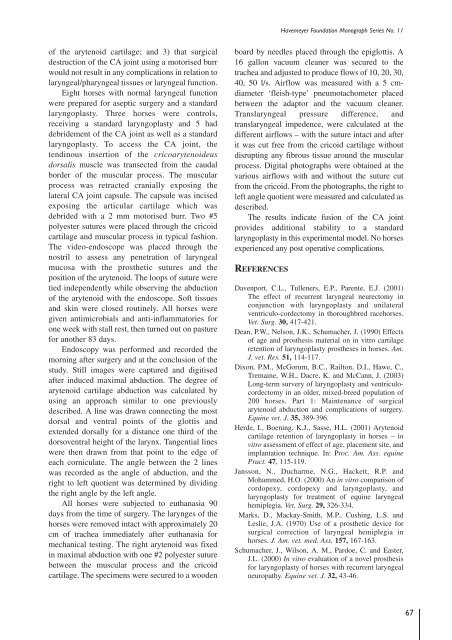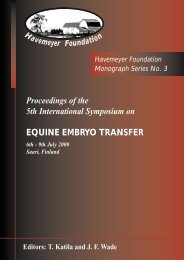Proceedings of a Workshop on - The Havemeyer Foundation
Proceedings of a Workshop on - The Havemeyer Foundation
Proceedings of a Workshop on - The Havemeyer Foundation
You also want an ePaper? Increase the reach of your titles
YUMPU automatically turns print PDFs into web optimized ePapers that Google loves.
<strong>Havemeyer</strong> Foundati<strong>on</strong> M<strong>on</strong>ograph Series No. 11<br />
<str<strong>on</strong>g>of</str<strong>on</strong>g> the arytenoid cartilage; and 3) that surgical<br />
destructi<strong>on</strong> <str<strong>on</strong>g>of</str<strong>on</strong>g> the CA joint using a motorised burr<br />
would not result in any complicati<strong>on</strong>s in relati<strong>on</strong> to<br />
laryngeal/pharyngeal tissues or laryngeal functi<strong>on</strong>.<br />
Eight horses with normal laryngeal functi<strong>on</strong><br />
were prepared for aseptic surgery and a standard<br />
laryngoplasty. Three horses were c<strong>on</strong>trols,<br />
receiving a standard laryngoplasty and 5 had<br />
debridement <str<strong>on</strong>g>of</str<strong>on</strong>g> the CA joint as well as a standard<br />
laryngoplasty. To access the CA joint, the<br />
tendinous inserti<strong>on</strong> <str<strong>on</strong>g>of</str<strong>on</strong>g> the cricoarytenoideus<br />
dorsalis muscle was transected from the caudal<br />
border <str<strong>on</strong>g>of</str<strong>on</strong>g> the muscular process. <strong>The</strong> muscular<br />
process was retracted cranially exposing the<br />
lateral CA joint capsule. <strong>The</strong> capsule was incised<br />
exposing the articular cartilage which was<br />
debrided with a 2 mm motorised burr. Two #5<br />
polyester sutures were placed through the cricoid<br />
cartilage and muscular process in typical fashi<strong>on</strong>.<br />
<strong>The</strong> video-endoscope was placed through the<br />
nostril to assess any penetrati<strong>on</strong> <str<strong>on</strong>g>of</str<strong>on</strong>g> laryngeal<br />
mucosa with the prosthetic sutures and the<br />
positi<strong>on</strong> <str<strong>on</strong>g>of</str<strong>on</strong>g> the arytenoid. <strong>The</strong> loops <str<strong>on</strong>g>of</str<strong>on</strong>g> suture were<br />
tied independently while observing the abducti<strong>on</strong><br />
<str<strong>on</strong>g>of</str<strong>on</strong>g> the arytenoid with the endoscope. S<str<strong>on</strong>g>of</str<strong>on</strong>g>t tissues<br />
and skin were closed routinely. All horses were<br />
given antimicrobials and anti-inflammatories for<br />
<strong>on</strong>e week with stall rest, then turned out <strong>on</strong> pasture<br />
for another 83 days.<br />
Endoscopy was performed and recorded the<br />
morning after surgery and at the c<strong>on</strong>clusi<strong>on</strong> <str<strong>on</strong>g>of</str<strong>on</strong>g> the<br />
study. Still images were captured and digitised<br />
after induced maximal abducti<strong>on</strong>. <strong>The</strong> degree <str<strong>on</strong>g>of</str<strong>on</strong>g><br />
arytenoid cartilage abducti<strong>on</strong> was calculated by<br />
using an approach similar to <strong>on</strong>e previously<br />
described. A line was drawn c<strong>on</strong>necting the most<br />
dorsal and ventral points <str<strong>on</strong>g>of</str<strong>on</strong>g> the glottis and<br />
extended dorsally for a distance <strong>on</strong>e third <str<strong>on</strong>g>of</str<strong>on</strong>g> the<br />
dorsoventral height <str<strong>on</strong>g>of</str<strong>on</strong>g> the larynx. Tangential lines<br />
were then drawn from that point to the edge <str<strong>on</strong>g>of</str<strong>on</strong>g><br />
each corniculate. <strong>The</strong> angle between the 2 lines<br />
was recorded as the angle <str<strong>on</strong>g>of</str<strong>on</strong>g> abducti<strong>on</strong>, and the<br />
right to left quotient was determined by dividing<br />
the right angle by the left angle.<br />
All horses were subjected to euthanasia 90<br />
days from the time <str<strong>on</strong>g>of</str<strong>on</strong>g> surgery. <strong>The</strong> larynges <str<strong>on</strong>g>of</str<strong>on</strong>g> the<br />
horses were removed intact with approximately 20<br />
cm <str<strong>on</strong>g>of</str<strong>on</strong>g> trachea immediately after euthanasia for<br />
mechanical testing. <strong>The</strong> right arytenoid was fixed<br />
in maximal abducti<strong>on</strong> with <strong>on</strong>e #2 polyester suture<br />
between the muscular process and the cricoid<br />
cartilage. <strong>The</strong> specimens were secured to a wooden<br />
board by needles placed through the epiglottis. A<br />
16 gall<strong>on</strong> vacuum cleaner was secured to the<br />
trachea and adjusted to produce flows <str<strong>on</strong>g>of</str<strong>on</strong>g> 10, 20, 30,<br />
40, 50 l/s. Airflow was measured with a 5 cmdiameter<br />
‘fleish-type’ pneumotachometer placed<br />
between the adaptor and the vacuum cleaner.<br />
Translaryngeal pressure difference, and<br />
translaryngeal impedence, were calculated at the<br />
different airflows – with the suture intact and after<br />
it was cut free from the cricoid cartilage without<br />
disrupting any fibrous tissue around the muscular<br />
process. Digital photographs were obtained at the<br />
various airflows with and without the suture cut<br />
from the cricoid. From the photographs, the right to<br />
left angle quotient were measured and calculated as<br />
described.<br />
<strong>The</strong> results indicate fusi<strong>on</strong> <str<strong>on</strong>g>of</str<strong>on</strong>g> the CA joint<br />
provides additi<strong>on</strong>al stability to a standard<br />
laryngoplasty in this experimental model. No horses<br />
experienced any post operative complicati<strong>on</strong>s.<br />
REFERENCES<br />
Davenport, C.L., Tulleners, E.P., Parente, E.J. (2001)<br />
<strong>The</strong> effect <str<strong>on</strong>g>of</str<strong>on</strong>g> recurrent laryngeal neurectomy in<br />
c<strong>on</strong>juncti<strong>on</strong> with laryngoplasty and unilateral<br />
ventriculo-cordectomy in thoroughbred racehorses.<br />
Vet. Surg. 30, 417-421.<br />
Dean, P.W., Nels<strong>on</strong>, J.K., Schumacher, J. (1990) Effects<br />
<str<strong>on</strong>g>of</str<strong>on</strong>g> age and prosthesis material <strong>on</strong> in vitro cartilage<br />
retenti<strong>on</strong> <str<strong>on</strong>g>of</str<strong>on</strong>g> laryngoplasty prostheses in horses. Am.<br />
J. vet. Res. 51, 114-117.<br />
Dix<strong>on</strong>, P.M., McGorum, B.C., Railt<strong>on</strong>, D.I., Hawe, C.,<br />
Tremaine, W.H., Dacre, K. and McCann, J. (2003)<br />
L<strong>on</strong>g-term survery <str<strong>on</strong>g>of</str<strong>on</strong>g> laryngoplasty and ventriculocordectomy<br />
in an older, mixed-breed populati<strong>on</strong> <str<strong>on</strong>g>of</str<strong>on</strong>g><br />
200 horses. Part 1: Maintenance <str<strong>on</strong>g>of</str<strong>on</strong>g> surgical<br />
arytenoid abducti<strong>on</strong> and complicati<strong>on</strong>s <str<strong>on</strong>g>of</str<strong>on</strong>g> surgery.<br />
Equine vet. J. 35, 389-396.<br />
Herde, I., Boening, K.J., Sasse, H.L. (2001) Arytenoid<br />
cartilage retenti<strong>on</strong> <str<strong>on</strong>g>of</str<strong>on</strong>g> laryngoplasty in horses – in<br />
vitro assessment <str<strong>on</strong>g>of</str<strong>on</strong>g> effect <str<strong>on</strong>g>of</str<strong>on</strong>g> age, placement site, and<br />
implantati<strong>on</strong> technique. In: Proc. Am. Ass. equine<br />
Pract. 47, 115-119.<br />
Janss<strong>on</strong>, N., Ducharme, N.G., Hackett, R.P. and<br />
Mohammed, H.O. (2000) An in vitro comparis<strong>on</strong> <str<strong>on</strong>g>of</str<strong>on</strong>g><br />
cordopexy, cordopexy and laryngoplasty, and<br />
laryngoplasty for treatment <str<strong>on</strong>g>of</str<strong>on</strong>g> equine laryngeal<br />
hemiplegia. Vet. Surg. 29, 326-334.<br />
Marks, D., Mackay-Smith, M.P., Cushing, L.S. and<br />
Leslie, J.A. (1970) Use <str<strong>on</strong>g>of</str<strong>on</strong>g> a prosthetic device for<br />
surgical correcti<strong>on</strong> <str<strong>on</strong>g>of</str<strong>on</strong>g> laryngeal hemiplegia in<br />
horses. J. Am. vet. med. Ass. 157, 167-163.<br />
Schumacher, J., Wils<strong>on</strong>, A. M., Pardoe, C. and Easter,<br />
J.L. (2000) In vitro evaluati<strong>on</strong> <str<strong>on</strong>g>of</str<strong>on</strong>g> a novel prosthesis<br />
for laryngoplasty <str<strong>on</strong>g>of</str<strong>on</strong>g> horses with recurrent laryngeal<br />
neuropathy. Equine vet. J. 32, 43-46.<br />
67








